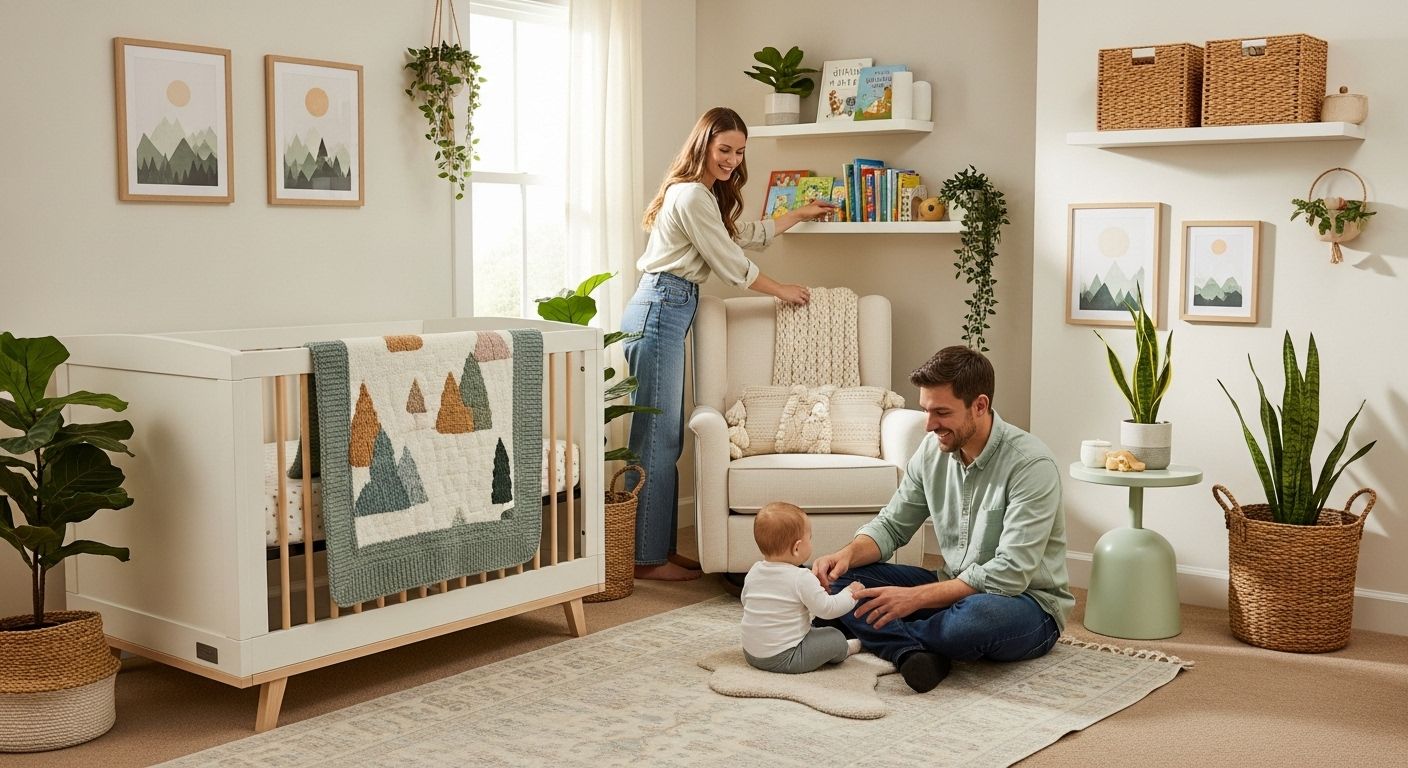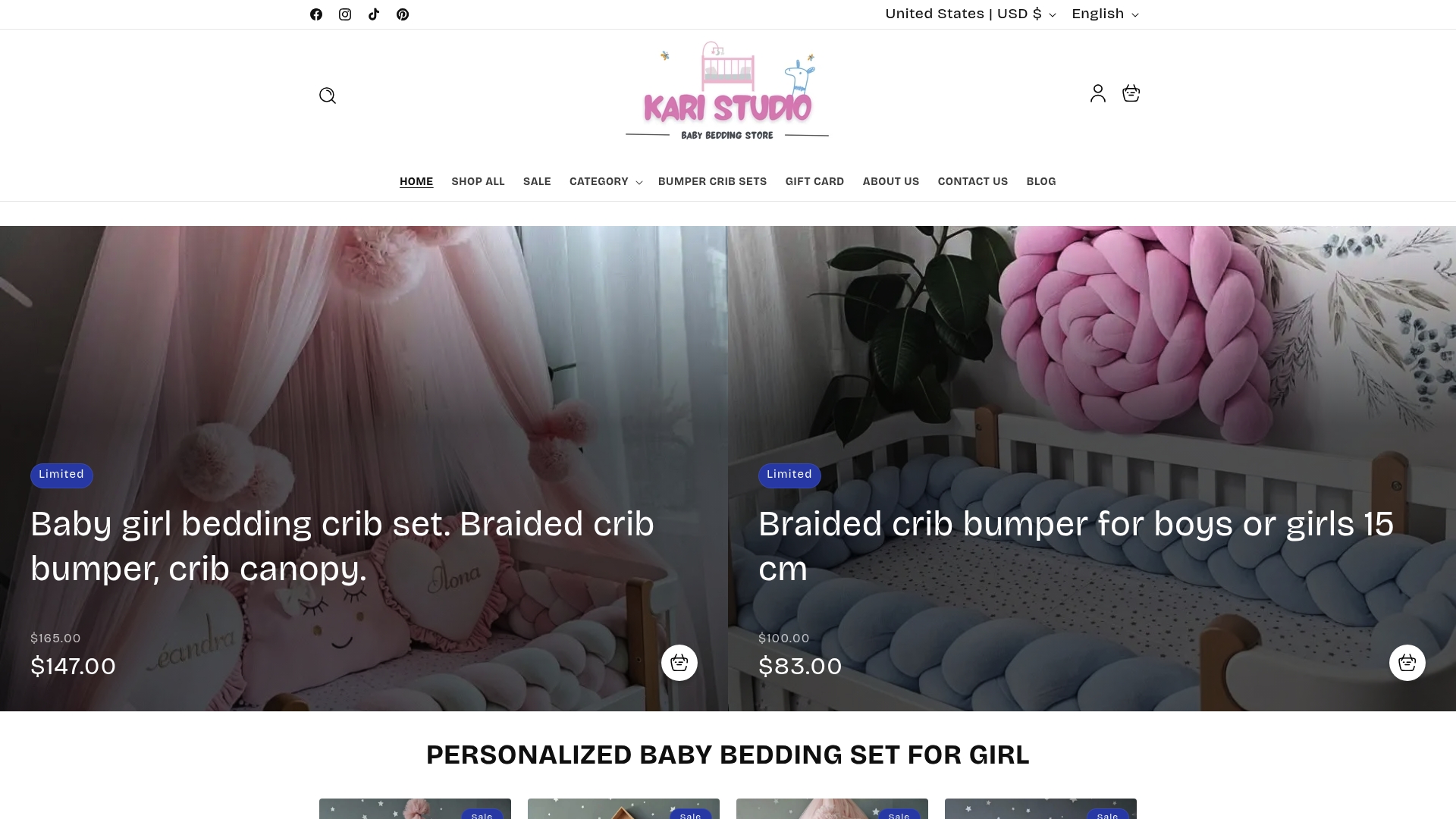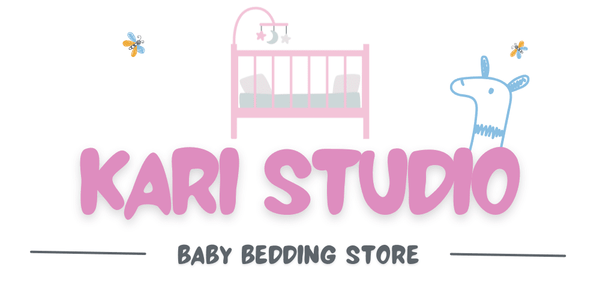
Parents spend countless hours picking out cribs and paint samples for their baby’s nursery, hoping every detail will create the perfect haven. Yet, over 60 percent of parents overlook crucial design choices that shape their infant’s comfort and development. The real surprise is that the colors on the wall or the arrangement of the furniture might actually influence your baby’s mood and learning more than the latest gadgets or toys ever could.
Table of Contents
- Choose A Soothing Color Palette
- Incorporate Functional Furniture
- Add Personalized Touches
- Utilize Wall Art Creatively
- Consider Nature-Inspired Decor
- Select Coordinating Textiles
- Incorporate Safe Lighting Options
- Use Multi-Purpose Storage Solutions
- Create A Reading Nook
- Keep Safety A Priority
Quick Summary
| Takeaway | Explanation |
|---|---|
| Choose calming colors for the nursery. | Use soft blues, greens, and neutrals to create a tranquil environment that supports your baby’s emotional well-being. |
| Opt for multi-functional furniture. | Select adaptable pieces like convertible cribs to maximize space and enhance utility as your child grows. |
| Personalize with sentimental decor. | Incorporate meaningful items like family photos and custom art to create a warm, inviting space that fosters connection. |
| Incorporate safe, soft lighting. | Use dimmable lights and gentle nightlights to regulate your baby’s sleep patterns while maintaining a soothing atmosphere. |
| Prioritize safety in your design. | Ensure all furniture is secured and materials are non-toxic to create a protective environment without sacrificing style. |
1: Choose a Soothing Color Palette
Creating a nursery is more than just arranging furniture - it’s about crafting an environment that nurtures your baby’s emotional and visual development. Color plays a pivotal role in setting the mood and supporting your infant’s sensory experiences. Research from Developmental Psychology Journal suggests that color choices can significantly impact an infant’s comfort and perception.
When selecting your nursery color palette, consider colors that promote calmness and tranquility. Soft, muted tones are scientifically proven to create a soothing atmosphere. These colors help regulate your baby’s emotional state and provide a sense of security.
Key color considerations for your nursery include:
- Soft blues that evoke a sense of serenity
- Gentle greens representing natural growth
- Warm neutrals that create a comforting backdrop
- Pale lavenders promoting relaxation
Color psychology reveals that infants respond differently to various hues. Avoid overly stimulating bright colors that might cause visual stress. Instead, opt for harmonious color combinations that create a gentle, nurturing environment. Pastel shades and earth tones work wonderfully in achieving this balance.
By six months, babies develop sophisticated color perception, making your palette choice crucial for their cognitive development. A well-chosen color scheme can subtly support your infant’s emerging visual skills while providing a peaceful sanctuary for rest and exploration.
2: Incorporate Functional Furniture
Designing a nursery requires a strategic approach to furniture selection that balances aesthetics with practicality. According to the National Institute of Child Health and Human Development, creating a safe and functional space is paramount for infant care and parental convenience.
Furniture in a nursery must serve multiple purposes while ensuring safety and efficiency. Parents need pieces that adapt to their growing child’s needs and simplify daily caregiving routines. The right furniture transforms a simple room into a comprehensive infant care environment.
Essential furniture pieces for a functional nursery include:
- A convertible crib that grows with your child
- A comfortable, supportive nursing chair
- A spacious changing station with storage
- A compact dresser for baby clothing and accessories
When selecting furniture, prioritize multi-functional designs that maximize space and utility. Convertible cribs that transform into toddler beds offer long-term value. Nursing chairs with built-in storage or gliding mechanisms provide comfort during late-night feedings. Changing tables with integrated storage help keep essential supplies within immediate reach.
Consider the room’s layout and dimensions when choosing furniture. Compact, streamlined pieces work best in smaller nurseries, while larger rooms can accommodate more elaborate setups. Modular furniture systems allow flexibility as your child grows, ensuring your nursery remains practical and relevant through different developmental stages.
3: Add Personalized Touches
A nursery is more than just a room - it is a narrative of family love and connection. Personalization transforms a generic space into a meaningful sanctuary that reflects your family’s unique story. According to the National Association for the Education of Young Children, creating environments that represent individual experiences supports a child’s emotional development.
Personalization goes beyond aesthetic choices. It is about creating a space that tells your family’s story and provides a sense of security and belonging for your child. Thoughtful personal elements can make the nursery feel warm, inviting, and deeply meaningful.
Consider incorporating personalized elements such as:
- Family photographs in decorative frames
- Handmade blankets or quilts with sentimental value
- Cultural artifacts representing family heritage
- Custom name art or monogrammed decor
These personal touches serve multiple purposes. They create visual interest, stimulate your baby’s cognitive development, and establish a connection to family history. Meaningful decorations can become conversation starters and treasured keepsakes as your child grows.
Remember that personalization does not mean overcrowding the space. Select items that have genuine emotional significance and complement the nursery’s overall design. A few carefully chosen pieces can communicate more love and intention than numerous random decorations.
4: Utilize Wall Art Creatively
Wall art transforms a nursery from a simple room into a stimulating environment that supports your baby’s cognitive and visual development. UNICEF’s early learning research highlights how strategic wall decorations can inspire imagination and foster learning experiences.
Creative wall art goes beyond aesthetic appeal. Visual stimulation plays a crucial role in infant brain development, making your wall choices more than just decorative decisions. Thoughtful artwork can introduce colors, shapes, and narratives that engage your baby’s emerging perceptual skills.
Consider incorporating wall art styles that support developmental milestones:
- Soft, high-contrast geometric patterns
- Educational illustrations with simple, clear images
- Gentle nature scenes with soothing color palettes
- Interactive wall decals that encourage visual tracking
Choose artwork that grows with your child. Removable wall decals offer flexibility, allowing you to update the nursery’s visual landscape as your baby develops. Texture and dimension can make wall art more engaging - consider pieces with subtle raised elements or mixed media approaches that invite gentle tactile exploration.
Remember that wall art should complement your nursery’s overall design. Select pieces that align with your color palette and furniture style, creating a cohesive visual environment that feels calm and intentional. The goal is to create a space that nurtures your baby’s curiosity while maintaining a sense of tranquility.
5: Consider Nature-Inspired Decor
Nature-inspired decor transforms nurseries into calming, developmental spaces that connect infants with the natural world. Research from the Children and Nature Network reveals that environmental exposure supports children’s cognitive, emotional, and physical growth.
Integrating natural elements creates a soothing atmosphere that stimulates sensory experiences and promotes learning. Organic design elements can introduce subtle textures, colors, and visual narratives that engage your baby’s developing perception.
Nature-inspired decor elements to consider include:
- Soft woodland creature illustrations
- Botanical wall prints with gentle green tones
- Natural wood furniture with minimal finishes
- Textured fabrics mimicking grass or leaf patterns
- Subtle landscape murals with calming scenery
When selecting nature-themed decor, focus on gentle, muted representations that do not overwhelm the space. Soft greens, warm browns, and subtle earth tones create a serene environment that feels connected to the natural world. Incorporate natural materials like wood, cotton, and linen to add authenticity and tactile richness.
Remember that nature-inspired decor is more than visual aesthetics. These design choices can subtly communicate themes of growth, nurturing, and interconnectedness, creating a meaningful backdrop for your baby’s early developmental journey.
6: Select Coordinating Textiles
Textiles are the soft language of nursery design, communicating comfort, warmth, and visual harmony. Cooper Hewitt’s Design Museum highlights how carefully chosen fabrics can transform a room’s aesthetic and emotional landscape.
Coordinating textiles create a cohesive sensory experience for your baby. Thoughtful selection of materials, patterns, and textures helps establish a calming environment that supports visual and tactile development.
Consider these key textile selection strategies:
- Match color palettes across curtains, rugs, and bedding
- Select fabrics with complementary texture variations
- Prioritize soft, hypoallergenic materials
- Choose washable and durable fabrics
- Mix subtle patterns with solid colors
When selecting nursery textiles, focus on layering and variety. Combine different fabric weights and textures to create visual depth. Cotton, muslin, and soft microfiber offer excellent comfort and practicality. Light, breathable materials work best for bedding, while slightly heavier fabrics can provide warmth in curtains and decorative elements.
Remember that textiles are not just decorative but functional. They regulate room temperature, absorb sound, and provide tactile stimulation for your developing infant. Choose materials that are gentle, easy to clean, and resistant to wear and tear.
7: Incorporate Safe Lighting Options
Lighting plays a critical role in creating a nurturing nursery environment. According to National Biotechnology Research, strategic lighting supports infant development by helping regulate circadian rhythms and creating a comfortable atmosphere.
Lighting design involves more than aesthetic choices. It impacts your baby’s sleep patterns, emotional regulation, and overall sensory experience. Proper illumination can transform a simple room into a safe, soothing sanctuary.
Key lighting considerations for nurseries include:
- Soft, dimmable overhead lighting
- Gentle nightlights with adjustable brightness
- Indirect lighting to reduce harsh shadows
- Warm color temperature bulbs
- Cordless and wall-mounted options
Position lighting to minimize direct glare and create layers of illumination. Soft, diffused light works best for nighttime feedings and diaper changes, allowing you to see clearly without disrupting your baby’s sleep cycle. Consider smart bulbs or plug-in dimmers that offer precise control over brightness and color temperature.
Remember that lighting serves multiple functions beyond visibility. It can create a calming atmosphere, support your baby’s natural sleep rhythms, and provide practical illumination for nighttime care. Choose fixtures that are securely mounted, use cool-to-the-touch bulbs, and offer flexible lighting options to adapt to your changing needs.
8: Use Multi-Purpose Storage Solutions
Storage is the unsung hero of nursery design, transforming chaos into organized comfort. eXtension Alliance for Better Child Care highlights the critical role of strategic storage in creating functional infant spaces.
Multi-purpose storage solutions maximize every inch of nursery space, adapting to your changing needs. Smart storage isn’t just about hiding clutter - it’s about creating an efficient, accessible environment that supports both parent and child.
Key storage strategies to consider:
- Floating shelves with hidden mounting hardware
- Under-crib storage drawers
- Modular cubbies with removable dividers
- Wall-mounted organizational systems
- Furniture with built-in compartments
Choose storage that grows with your child. Convertible designs that transition from diaper storage to toy organization offer long-term value. Vertical storage solutions help maximize limited floor space, allowing you to keep essential items within reach without cluttering the nursery.
Consider safety when selecting storage. Rounded edges, secure mounting, and childproof closures protect curious explorers. Label storage containers to maintain organization and create a system that allows quick access to frequently used items. Remember that effective storage is about creating a calm, structured environment that supports your baby’s development and your parental peace of mind.
9: Create a Reading Nook
A reading nook transforms an ordinary nursery into a magical learning sanctuary. According to the Child Mind Institute, dedicated reading spaces support critical language development and create meaningful parent-child bonding opportunities.
Reading nooks are more than physical spaces - they are invitations to imagination, learning, and connection. By designing a comfortable, engaging area, you create a lifelong foundation for literacy and curiosity.
Essential elements for an ideal reading nook include:
- Comfortable seating with soft cushions
- Soft, warm lighting
- Accessible book storage
- Cozy, washable blankets
- Low, child-friendly bookshelves
Position your reading nook in a quiet corner with natural light, away from high-traffic areas. Soft textures and gentle colors help create a soothing environment that encourages relaxation and concentration. Consider adding a small, washable rug to define the space and provide additional comfort.
Remember that your reading nook will evolve with your child. Start with board books and soft seating, knowing that this space will grow into a cherished spot for storytelling, learning, and quiet moments of connection.
10: Keep Safety a Priority
Safety transforms nursery design from aesthetically pleasing to genuinely protective. The Consumer Product Safety Commission emphasizes that intentional safety measures prevent potential accidents and create secure environments for infants.
Safety is not an afterthought - it is the foundation of responsible nursery design. Every design choice should prioritize your baby’s protection without compromising aesthetic appeal or comfort.
Critical safety considerations include:
- Secure furniture anchoring to prevent tipping
- Cordless window treatments
- Rounded furniture edges
- Non-toxic paint and materials
- Electrical outlet covers
- Stable, low-height furniture
Consider the nursery from your baby’s perspective. Low furniture placement reduces climbing risks, while strategic positioning keeps hazardous items out of reach. Install safety gates, secure loose rugs, and ensure all furniture meets current safety standards. Regular safety assessments help identify and mitigate potential risks as your baby becomes more mobile.
Remember that safety evolves with your child’s developmental stages. What works for a newborn will change as they begin crawling, walking, and exploring. Maintain a proactive approach, regularly reassessing your nursery’s safety features to create a protective, nurturing environment.
Below is a comprehensive table summarizing the top nursery decor ideas for creating a cozy, functional, and safe baby space discussed in the article.
| Key Decor Idea | Main Focus | Benefits/Outcomes |
|---|---|---|
| Soothing Color Palette | Use soft, tranquil hues | Promotes emotional well-being and visual development |
| Functional Furniture | Multi-purpose, adaptable pieces | Maximizes space, grows with child, enhances caregiving |
| Personalized Touches | Family photos, custom art, meaningful items | Fosters connection, security, and family story |
| Creative Wall Art | Educational and interactive decor | Boosts cognitive and sensory stimulation |
| Nature-Inspired Decor | Woodland themes, natural materials | Provides calming atmosphere, connects to natural world |
| Coordinating Textiles | Harmonized, soft, hypoallergenic fabrics | Enhances comfort, safety, and cohesive design |
| Safe Lighting Options | Dimmable lights, warm tones, secure fixtures | Regulates sleep, provides comfort and safe illumination |
| Multi-Purpose Storage Solutions | Modular, vertical, and hidden storage | Reduces clutter, organizes efficiently |
| Reading Nook | Cozy seating, accessible books, soft lighting | Encourages literacy, relaxation, and bonding |
| Safety Prioritization | Secure, non-toxic materials and anchored furniture | Ensures protective environment throughout development |
Bring Your Nursery Vision to Life with Kari Studio
You have big dreams for your baby’s space. From choosing soothing color palettes to ensuring every detail feels safe and personal, creating a cozy nursery can feel overwhelming when you want quality and style. Maybe you are struggling to find beautiful accessories that balance soft textures, safety, and coordinated design, just like the article describes. At Kari Studio, we see the love and intention you pour into every choice. Our curated crib bumpers and nursery accessories are designed with comfort, functionality, and charm at their core, supporting the warm, organized environment you envision, from muted textiles to playful themed details.

Ready to transform inspiration into reality? Discover a collection that matches your decorating goals and gives your family peace of mind. Start exploring the nursery essentials at Kari Studio, enjoy a seamless shopping experience, and enjoy worldwide delivery. Shop now to create a joyful baby space filled with comfort and style made just for you.
Frequently Asked Questions
What colors are best for a baby’s nursery?
Soft, muted tones such as light blues, gentle greens, warm neutrals, and pale lavenders are ideal for creating a calming atmosphere that supports emotional development in infants.
How can I make my nursery more functional?
Incorporate multi-purpose furniture like convertible cribs, nursing chairs with storage, and changing stations to maximize space and convenience while ensuring safety for your baby.
What types of wall art are suitable for nurseries?
High-contrast geometric patterns, educational illustrations, nature scenes in soft colors, and interactive wall decals can provide visual stimulation and support cognitive development for infants.
How can I ensure safety in my baby’s nursery?
Prioritize safety by securing furniture to prevent tipping, using cordless window treatments, selecting non-toxic materials, and implementing proper electrical outlet covers to create a protective environment.

